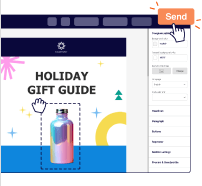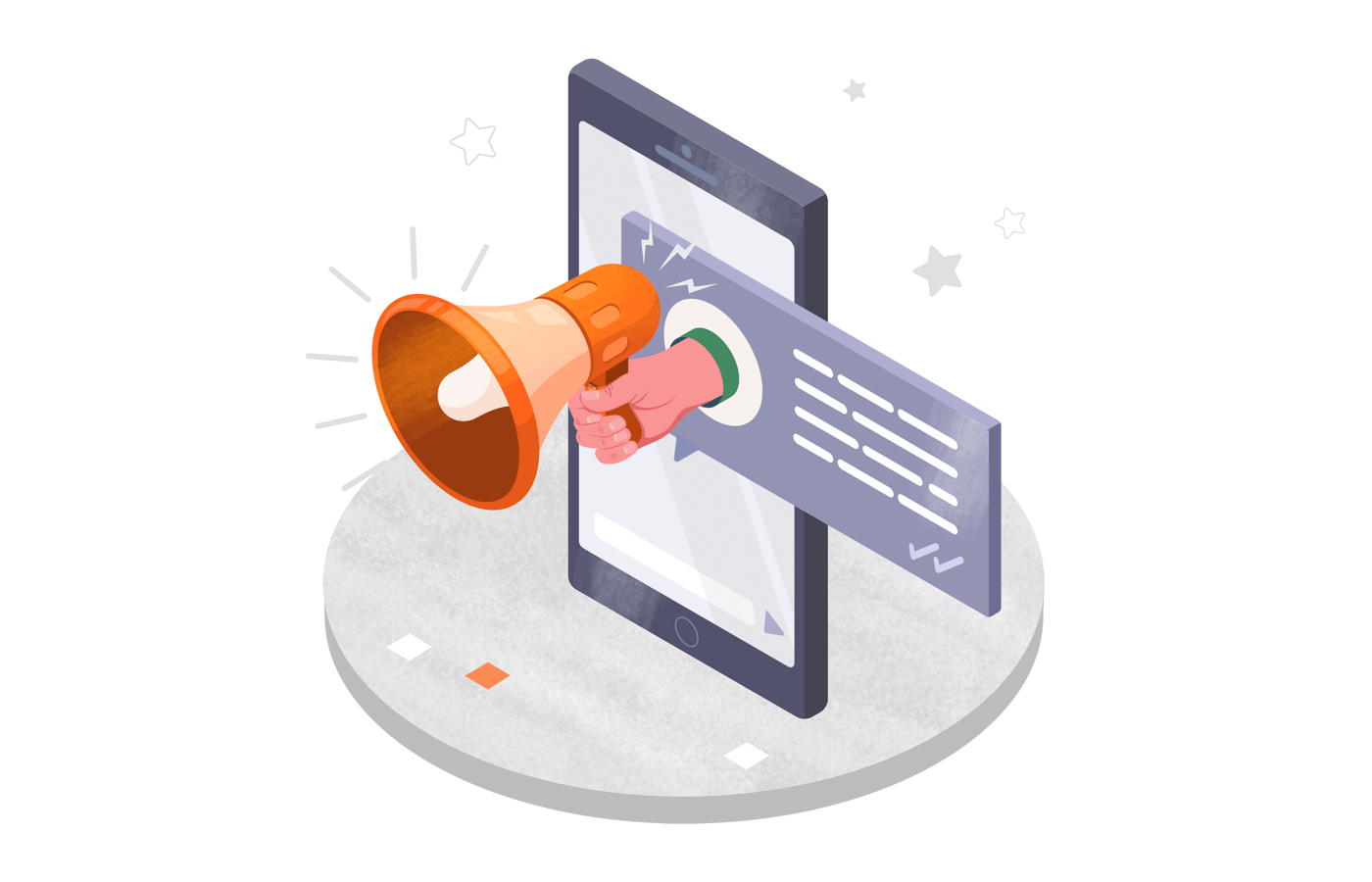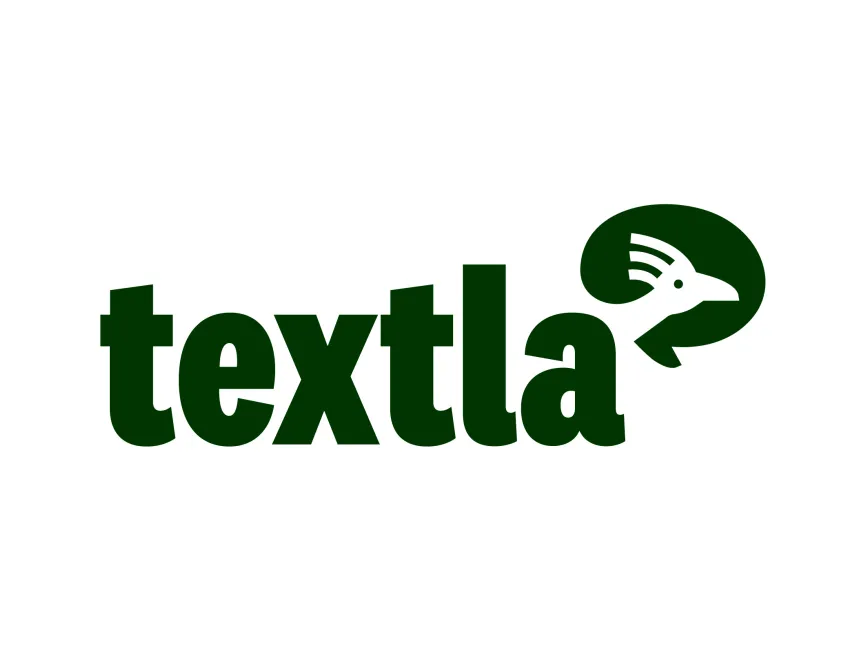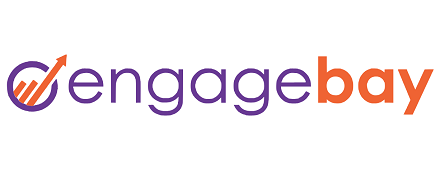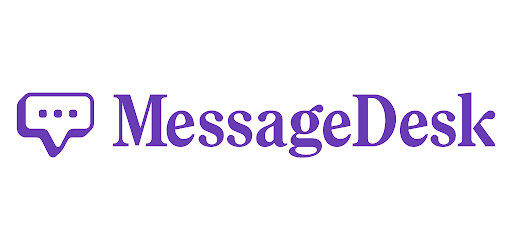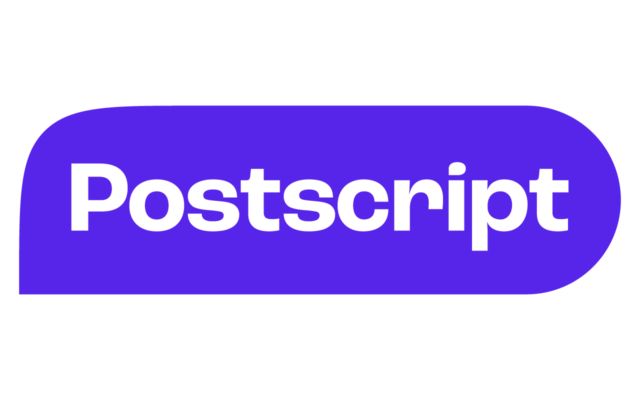Using SMS marketing platforms has become essential for boosting engagement and conversions.
People check their phones 96 times a day, according to the latest SMS marketing statistics. With SMS open rates outperforming most channels, brands that skip text marketing simply leave money on the table.
We’ve personally tested dozens of SMS marketing automation tools and seen what works across different industries.
In this blog, we’ve reviewed different platforms with real insights and use cases. So, if you’re looking to boost text message campaigns, you’ll find a tool here that fits your strategy, and your budget.
Let’s get started.
Disclaimer: This article evaluates various SMS marketing platforms, including Sender, which our company owns. We present assessments based on research, industry standards, and user feedback. We selected these platforms after comparing their features, pricing, and performance. We don’t earn any commissions from links in this article.
What is an SMS Marketing Platform?
An SMS marketing platform is a tool that helps businesses send transactional or promotional text messages directly to a customer’s personal phone.
These platforms handle everything from mass text message services to personalized SMS automation workflows, ensuring your message gets delivered fast, and read almost instantly.
Most tools offer features like bulk texting, SMS API integration, compliance management, and real-time performance tracking.
So, whether you’re running flash sales, sending healthcare appointment reminders, or following up on abandoned carts, you can utilize the platform to increase engagement and conversions.
Best SMS Marketing Platforms — Quick Comparison
Want to quickly compare all the SMS marketing platforms in this blog? Check out this table covering all the tools—their features, pricing, use cases, and integration capabilities:
| Platform | Key Features | Pricing | Best For | Integrations |
| Sender | Affordable pricing, Email + SMS, Automation workflows, High deliverability | Starts at $7/month | Small businesses, ecommerce | Shopify, WordPress, Zapier, WooCommerce & other |
| Textla | Two-way texting, Scheduling, Real-time analytics, MMS support | Starts at $25/month + $0.01/SMS | Service providers, Local businesses | CRM tools, Custom APIs |
| Omnisend | Automation workflows, Advanced segmentation | Starts at $16/month | Ecommerce | Shopify, BigCommerce, WordPress |
| TextMagic | Pay-as-you-go, Bulk SMS, Two-way messaging, API integration | Starts at $0.045/SMS | Transactional messaging, International use | CRM, Custom APIs |
| Klaviyo | Advanced segmentation, SMS + MMS, Shopify-first, Omnichannel automation | Starts at $35/month | Ecommerce, DTC brands | Shopify, BigCommerce, WooCommerce |
| EngageBay | CRM integration, Bulk messaging, Automation triggers, Two-way texting | Starts at $14.99/month | SMBs, CRM-focused teams | HubSpot, Zapier, email tools |
| SlickText | Analytics dashboard, Keyword campaigns, Shortcode SMS, Automation builder | Starts at $29/month | Retail, Small businesses | Zapier, Email tools, CRM |
| MessageDesk | Shared inbox, VoIP/toll-free, Templates, CRM-style contact management | Available on request | Internal teams, Secure communication | QuickBooks, CRM tools |
| Textedly | Two-way texting, Shared inbox, Keyword triggers, Scheduling | Starts at $26/month | Customer service, Healthcare | CRM, Custom APIs |
| SimpleTexting | Drip campaigns, Two-way SMS, Opt-in tools, Analytics | Starts at $29/month | New users, Event marketing | HubSpot, Mailchimp, Zapier |
| Attentive | AI personalization, MMS, Real-time replies, Ecommerce flows | On-demand pricing model | Mid-size to large ecommerce brands | Shopify, ESPs, Loyalty platforms |
| Postscript | Shopify sync, Event automation, MMS, TCPA compliance | Starts at $30/month | Shopify stores, DTC brands | Shopify, ESPs, Loyalty apps |
| Zonka Feedback | SMS surveys, Sentiment analysis, Real-time feedback, Automation | Starts at $49/month | Customer experience teams, Service businesses | Zendesk, CRMs, Web tools |
Tips for Choosing the Right SMS Marketing Platform
Not all of them are created equal, so before you choose your text message marketing software, you should:
- Understand your needs. Before selecting an SMS marketing solution, it’s crucial to define your SMS marketing strategy clearly the volume of messages you plan to send, the types of campaigns you want to run, why you want to integrate SMS, and any specific features you need to achieve your marketing goals;
- Evaluate features and integrations. Look into the features offered by each platform: scheduling, personalization, automation, and analytics. Also, consider how well the platform integrates with other tools and software you use;
- Consider pricing and scalability. Compare the pricing models of different SMS marketing platforms to find one that fits your budget and offers good value for money. Also, consider the platform’s scalability, ensuring it can accommodate your growing needs as your business expands without a sudden spike in costs.
13 Best SMS Marketing Platforms in 2025
If you want an in-depth review of the best platforms you can choose from, we’ve highlighted the standout features, experience, and the best fit for each of these tools. Check out our best recommendations and make an informed pick.
- Sender
- Textla
- Omnisend
- TextMagic
- Klaviyo
- EngageBay
- SlickText
- MessageDesk
- Textedly
- SimpleTexting
- Attentive
- Postscript
- Zonka Feedback
1. Sender — Most Affordable Email and SMS Marketing Platform
⭐️ Trusted by 180,000+ businesses worldwide.
Looking for a low-cost SMS marketing platform that doesn’t skimp on features? Sender is the best SMS marketing service with an extensive feature set. This platform offers email and SMS marketing, including a multichannel automation solution that’s easy to set up and affordable too.
Pricing: Starts at $7/month for the Standard plan with SMS campaigns and $14/month for SMS with advanced automation capabilities | Forever free plan for email campaigns for up to 2,500 subscribers.
Sender throws complicated setups out the window, and the platform’s strength lies in its simplicity.
Setting up campaigns is quick, the user interface is clean, and its SMS delivery rates are consistent. We’ve seen many clients using it for flash sale promotions and enjoying prompt delivery rates, even during peak hours.
Want to automate personalized messages based on behavior, recover abandoned carts, or re-engage silent subscribers? Sender’s automation workflows are here to help. Plus, you get robust analytics and reporting to keep an eye on your campaign’s performance in real-time.
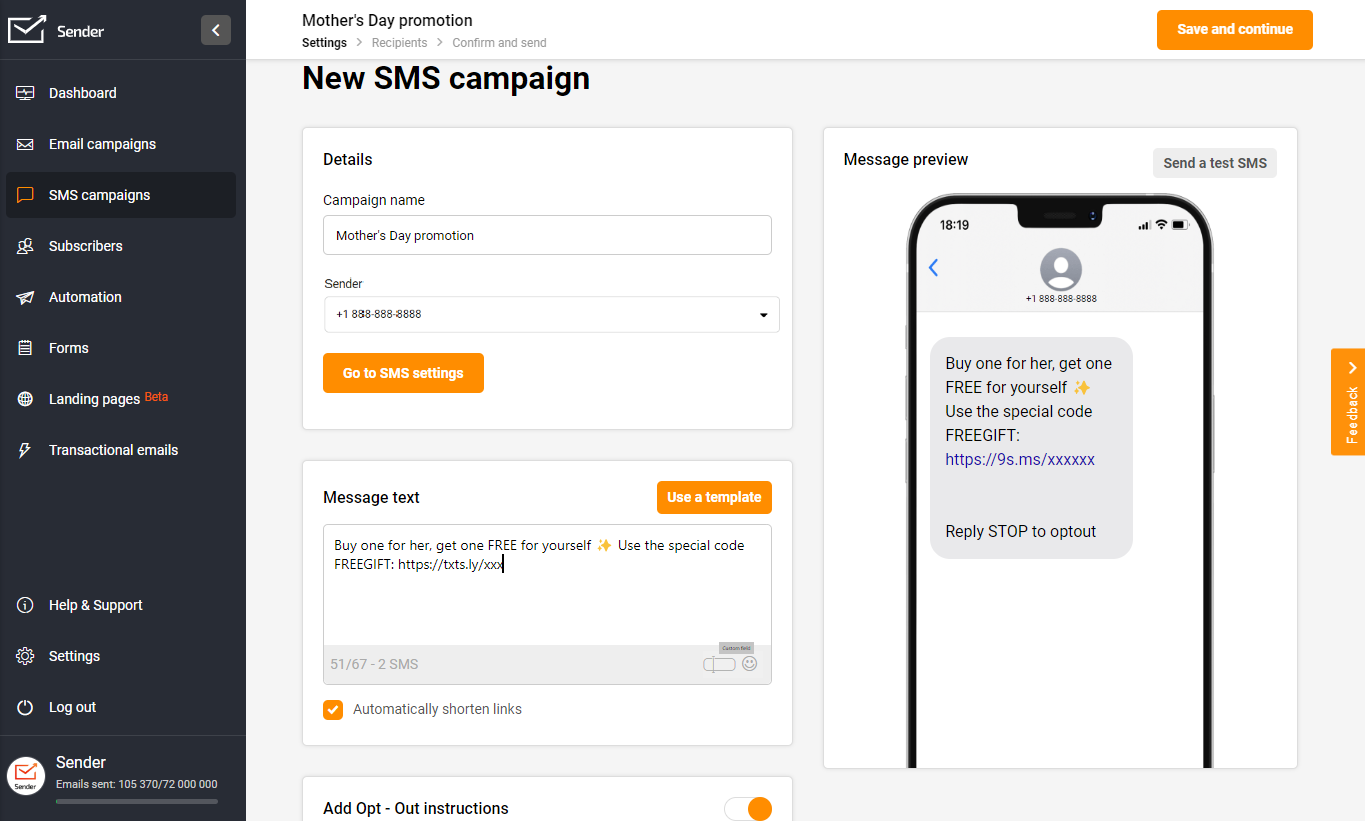
Standout Features
- Email and SMS marketing. Manage email and text message campaigns from a single, easy-to-use dashboard.
- SMS automation builder. Set up welcome messages, order updates, or promotional SMS flows in minutes.
- Affordable pricing tiers. Great for small businesses or startups on a tight marketing budget.
- High SMS deliverability. Reliable SMS delivery rates, even for international campaigns across time zones.
Industry Fit
By using Sender different kinds of businesses can scale via SMS marketing without high spending. Here are some use cases:
- Ecommerce. Send automated product recommendations, abandoned cart reminders, and post-purchase follow-ups to boost sales;
- SaaS companies. Send recurring messages for subscription reminders, send onboarding sequences, and reduce churn with re-engagement campaigns;
- Event marketers. Combine email and SMS to drive ticket sales, send last-minute updates, and keep attendees informed.
Competitive Edge
Compared to many other SMS marketing services, Sender is far more accessible in terms of pricing and ease of use. Sender is an omnichannel solution, giving equal weightage to both SMS and email, making it more suitable for small teams running lean campaigns.
- Better value for money as an SMS marketing platform with affordable plans starting at just $7/month;
- Easy setup with an intuitive UI to get started within minutes even for beginners with no tech knowledge;
- Omnichannel support for email + SMS campaigns to engage your audience across channels without switching tools.
- Supports international SMS in 48+ countries across Europe, The Americas, Asia, Australia, and Africa; rates vary by country.
2. Textla — Leading Text Messaging Service for Businesses
Textla is a well-rounded text messaging service that delivers simplicity, scale, and serious results. Whether you’re sending a few hundred messages or millions, the platform makes SMS feel easy, even for teams with zero tech background.
Pricing: Starts at $25/month + $.01 per text | 14-day free trial available
We ran a few text message campaigns using Textla for testing purposes. What stood out most was how intuitive the platform was. It had almost no learning curve. From setting up automated texting services to segmenting lists, everything felt smooth and well-supported.
You can run bulk campaigns, create SMS automation workflows, send MMS with GIFs, and even personalize with sender IDs—all from one clean dashboard.
It’s built for brands that care about SMS compliance, SMS consent management, and engagement. Plus, the platform also integrates with CRM and ecommerce tools and supports automated messaging flows.
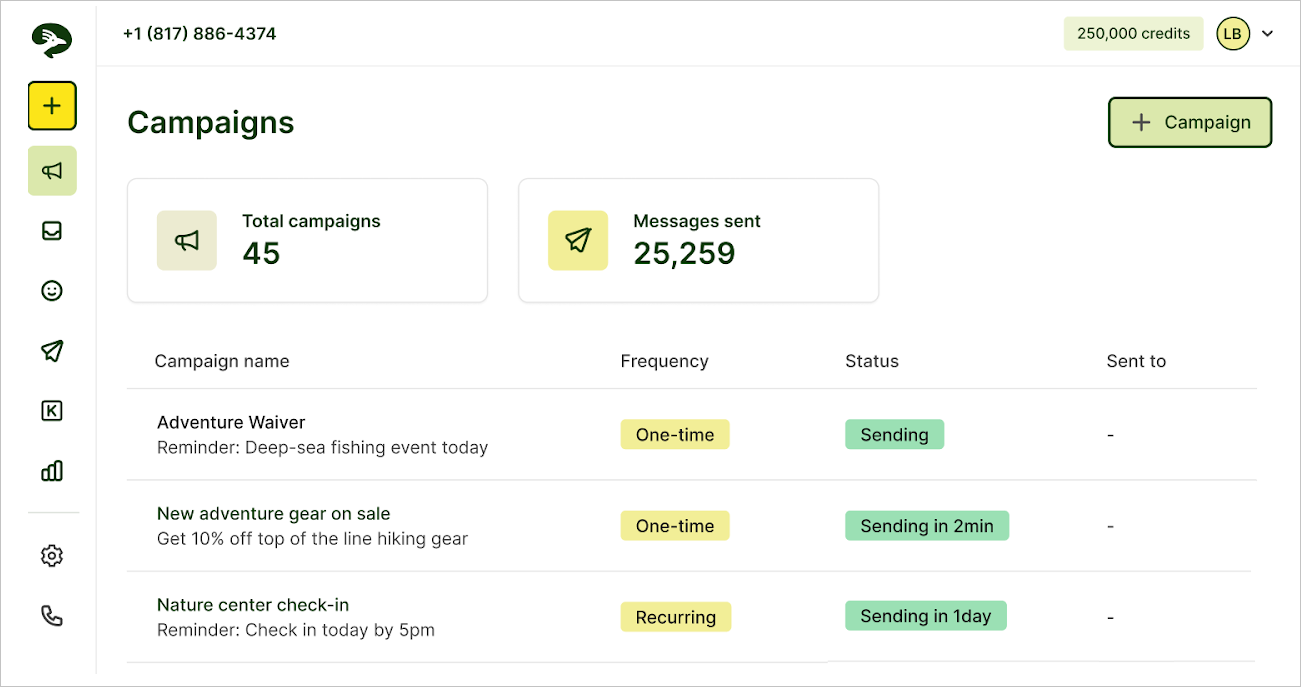
Standout Features
- Visual UI. Easily create text message campaigns—no coding or tech experience needed;
- High-volume scalability. Handles both small-batch sends and enterprise-level bulk text messaging services;
- Real-time insights. View SMS open rates, clicks, and conversions in a clean analytics dashboard;
- Compliance built-in. Includes tools for text message privacy laws, opt-outs, and SMS consent management.
Industry Fit
Textla is a great solution for service-driven brands that rely on time-sensitive customer communication. Here are some use cases:
- SMS marketing for restaurants. Create event-based text marketing campaigns, restaurant text message promotions, send coupon codes, and new menu announcements directly to your customers’ mobile phones;
- SMS marketing for appointment reminders. Reduce no-shows and improve appointment attendance rates with timely appointment reminders sent via SMS;
- SMS marketing for service providers. Gather valuable feedback from your customers through quick and easy SMS surveys.
Competitive Edge
Textla is designed to be accessible and easy to use, making it a great option for businesses new to SMS marketing. It also makes international SMS regulations and compliance easy to manage. If you need a mass text message service with simplicity, go with it.
- Clean, intuitive UI makes campaign creation easy even for non-tech users;
- Built-in consent tools help you stay compliant with global SMS regulations effortlessly;
- Handles both small and large-scale SMS sends without compromising speed or deliverability;
- Seamlessly connect to your existing tools via integrations to personalize messages at scale;
- Supports international SMS with pay-as-you-go pricing by country.
Textla has made quick communication with our customers so easy. We are able to segment our lists and send with ease.
– Nikki from G2
3. Omnisend — Ecommerce-Focused SMS Marketing
Omnisend is a powerful SMS marketing platform purpose-built for ecommerce. With native email, SMS, and push notifications under one roof, it helps brands create highly targeted, automated campaigns without juggling multiple tools.
Pricing: Free plan available | Paid plans start at $16/month for 500 contacts and 6,000 emails | Includes $1 in SMS credits.
We tested Omnisend across multiple Shopify stores and were impressed with how fast we could build multi-step automations for SMS—especially when pairing them with email and push notifications in the same flow.
You can trigger messages based on specific customer actions—like browsing activity, cart abandonment, or product purchases—making each SMS feel relevant and timed perfectly. It also supports international SMS campaigns and offers visual workflows that simplify complex automation setups.

Standout Features
- Pre-built automation workflows: Cart recovery, welcome series, order updates—all customizable with SMS included;
- Behavior-based segmentation: Target customers using purchase history, on-site activity, or email engagement;
- Multichannel integration: Connect email, SMS, and push notifications into one campaign without third-party tools;
- Drag-and-drop builder: Build automation flows visually with customizable messages for each channel.
Industry Fit
Omnisend is ideal for ecommerce brands that want to send personalized, timely SMS messages that complement broader marketing efforts. Top use cases include:
- Promotional SMS for online stores: Trigger timely product offers, discounts, or seasonal campaigns via text;
- Post-purchase messaging: Send delivery updates or ask for reviews using automated SMS flows;
- List growth via mobile: Capture SMS subscribers through gamified popups and mobile-first signup forms.
Competitive Edge
What sets Omnisend apart is its all-in-one design. You don’t need to bolt on SMS or switch platforms to manage omnichannel campaigns. Everything—including SMS credits—is managed in a unified dashboard. Plus, advanced features like A/B testing, real-time reporting, and 24/7 customer support are available on all plans.
- Visual automation builder for multichannel campaigns;
- Built-in SMS/MMS support with global reach;
- Ecommerce-specific triggers and segmentation tools;
- 24/7 live chat support included on every plan.
Overall, my experience with Omnisend has been good. It’s easy to use, with helpful email and SMS automation, and the templates save time. While design options are a bit limited and costs can rise as your list grows, it’s a solid tool for marketing.
— Dauanie from Capterra
4. TextMagic — Best Online SMS Service for Pay-As-You-Go Messages
TextMagic is a global SMS marketing platform that caters to businesses of all sizes with its flexible and affordable pay-as-you-go pricing model.
It’s an excellent choice for businesses that need a reliable solution to send transactional messages, alerts, and marketing campaigns without long-term contracts. If you want to test the waters before committing to a bulk SMS pricing plan, TextMagic is a great option.
Pricing: Usage based pricing starting at $0.049 / SMS for U.S. audience | Free trial available
TextMagic offers a wide range of features, including bulk SMS, two-way messaging, SMS scheduling, and detailed reporting. Its user-friendly platform allows businesses to send messages, automate campaigns, and track results in real time.
We tried our hand on TextMagic with a hypothetical scenario for a service-based business and found it incredibly useful for order notifications, two-factor authentication via SMS, and quick customer updates.
The platform handled bulk text messaging services well, with reliable SMS delivery rates, even for international messages.
Its web dashboard is easy to learn, and SMS API integration is straightforward if you’re connecting it to your CRM or website. If you’re focused on control, flexibility, and low overheads, TextMagic gets the job done without locking you into a monthly plan.
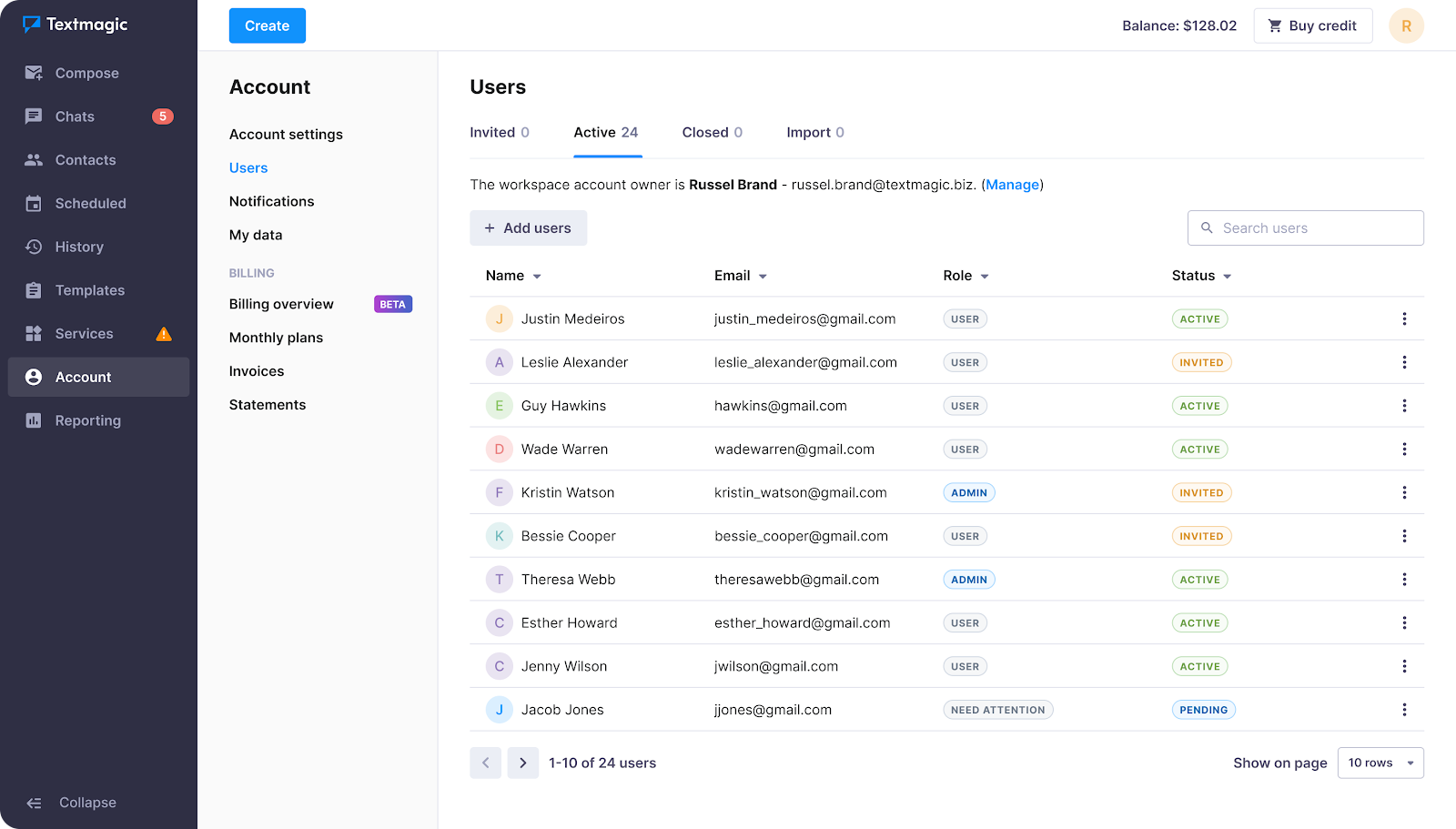
Standout Features
- Global SMS coverage. Reach over 200 countries with consistently strong SMS delivery rates;
- No monthly fees. Great for businesses that want bulk messaging without long-term contracts;
- Real-time reporting. Track open rates, delivery status, and performance inside an intuitive dashboard;
- Developer integration. Easy-to-use SMS API integration for websites, mobile apps, web apps, and CRMs.
Industry Fit
TextMagic is useful for transactional messaging and real-time alerts across industries. Here are some use cases:
- Order confirmations. Send instant order confirmations and shipping notifications to customers worldwide;
- Appointment reminders. Reduce no-shows and improve efficiency by sending automated appointment reminders via SMS;
- Two-factor authentication. Enhance security for your online platforms and applications by implementing two-factor authentication via SMS.
Competitive Edge
This text messaging service requires no subscription or minimum volume, making it ideal for all business sizes. With easy setup, bulk texting, and real-time tracking, it lets you start small, scale fast, and control your mobile marketing strategy.
- Flexible pricing model with no contracts or commitments—only pay for the messages you send;
- Has iOS & Android apps; supports SMS in 24+ countries with location-based pricing;
- Easy to launch campaigns and connect APIs, even for non-technical users;
- Great for order updates, OTPs, reminders, and instant customer alerts.
Sending a message is incredibly simple. Just input the number (which autoformats), type your message and hit send.
– Ray from G2
5. Klaviyo — SMS Marketing Service for SMS Messages & MMS
Klaviyo is a popular choice for businesses looking to combine SMS marketing with email marketing. Known for its robust segmentation and automation capabilities, Klaviyo lets you tailor SMS messages and MMS campaigns to specific customer segments.
This means you can send targeted promotions, personalized reminders, and even interactive campaigns that feel more likeI th a conversation than a blast to the masses.
Pricing: Starts at $30/month for up to 1,000 subscribers and 10,000 emails | Free plan available.
We tested Klaviyo with some Shopify stores, and what stood out was how smooth it was to create audience-based triggers.
You can set up text message campaigns based on customer behavior, like what they browsed, bought, or abandoned. Plus, the MMS support (images, GIFs, clickable links) makes your texts feel way more engaging than plain alerts.
You also get cross-channel marketing integration, powerful reporting, and intuitive flows that actually help increase click-through rates for SMS.
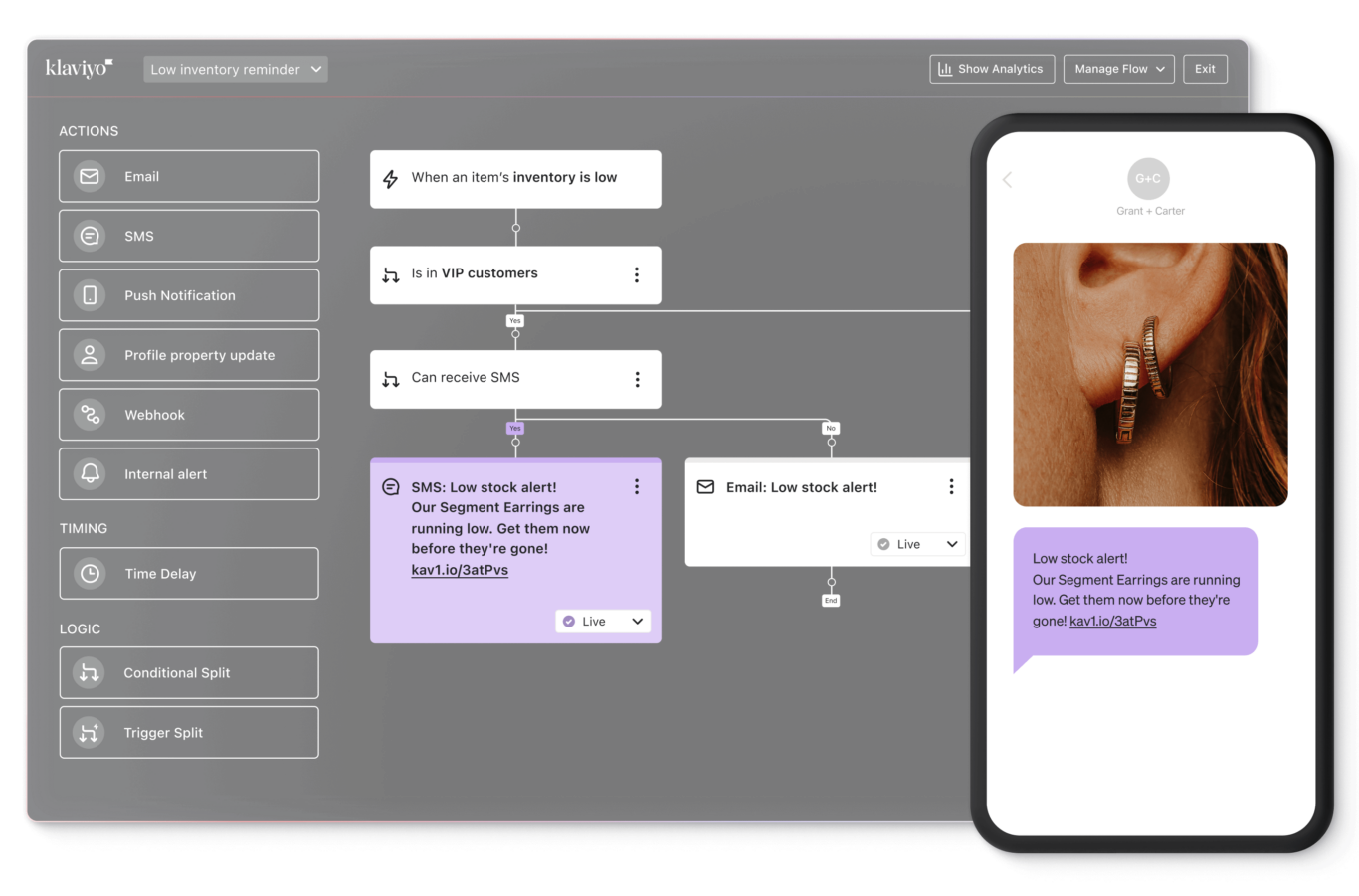
Standout Features
- Behavior-based targeting. Automate texts based on views, purchases, and email engagement across the funnel;
- MMS message support. Use images, GIFs, and links to drive higher text message conversion rates;
- Shopify-first integration. Syncs seamlessly with Shopify for detailed product triggers and segment updates;
- Cross-channel automation. Connect email, SMS, and push notifications into one workflow for stronger results.
Industry Fit
Klaviyo is primarily designed for ecommerce stores that need instant delivery to engage their customers. Here are some use cases:
- SMS marketing for online stores. Suggest relevant products to customers via SMS automation tools based on their browsing history and past purchases;
- SMS marketing for retail. Re-engage inactive customers with promotional SMS messages and exclusive offers tailored to their interests;
- SMS marketing for small businesses. Keep customers informed about their orders with automated shipping notifications and delivery reminders.
Competitive Edge
Klaviyo’s strength lies in its data-driven approach to marketing automation. You can segment audiences based on combined email + SMS behavior, run A/B tests, and fine-tune campaigns that speak to your customer at exactly the right time.
- Shopify-first focus with built-in triggers for product views, cart activity, and purchases;
- Advanced segmentation based on multi-channel behavior, purchase history, and engagement patterns;
- Cross-channel automation to combine SMS, email, and push into unified customer journeys without needing extra tools;
- Powerful analytics dashboards to monitor A/B tests and optimize message timing for better ROI;
- Has an iOS & Android app; offers global SMS in 20+ countries, pricing varies based on destination.
Comprehensive email and SMS marketing solution. Being able to target customers with personalized information is important and a huge part of our marketing strategy.
– Anna from G2
6. EngageBay — Best SMS Marketing Software with CRM Solution
EngageBay isn’t just an SMS marketing platform—it’s a full-stack marketing and CRM tool that brings SMS, email, sales, and support into one ecosystem. If you’re tired of juggling five different tools, EngageBay keeps everything under one roof.
Pricing: Starts at $14.99/month for up to 500 contacts | Free plan available for up to 250 contacts
We tested EngageBay for text message campaigns and were impressed by how easy it was to sync CRM data with SMS automation. You can set up bulk text messaging services, build sequences based on behavior triggers, and manage everything from a single dashboard. The CRM-SMS sync means every campaign is contextual and highly likely to convert.
For growing businesses, it offers that sweet spot of affordability, scalability, and automation without the tech overwhelm. If you’re looking to connect SMS with your mobile marketing strategy, EngageBay’s workflow automation will save you serious time.
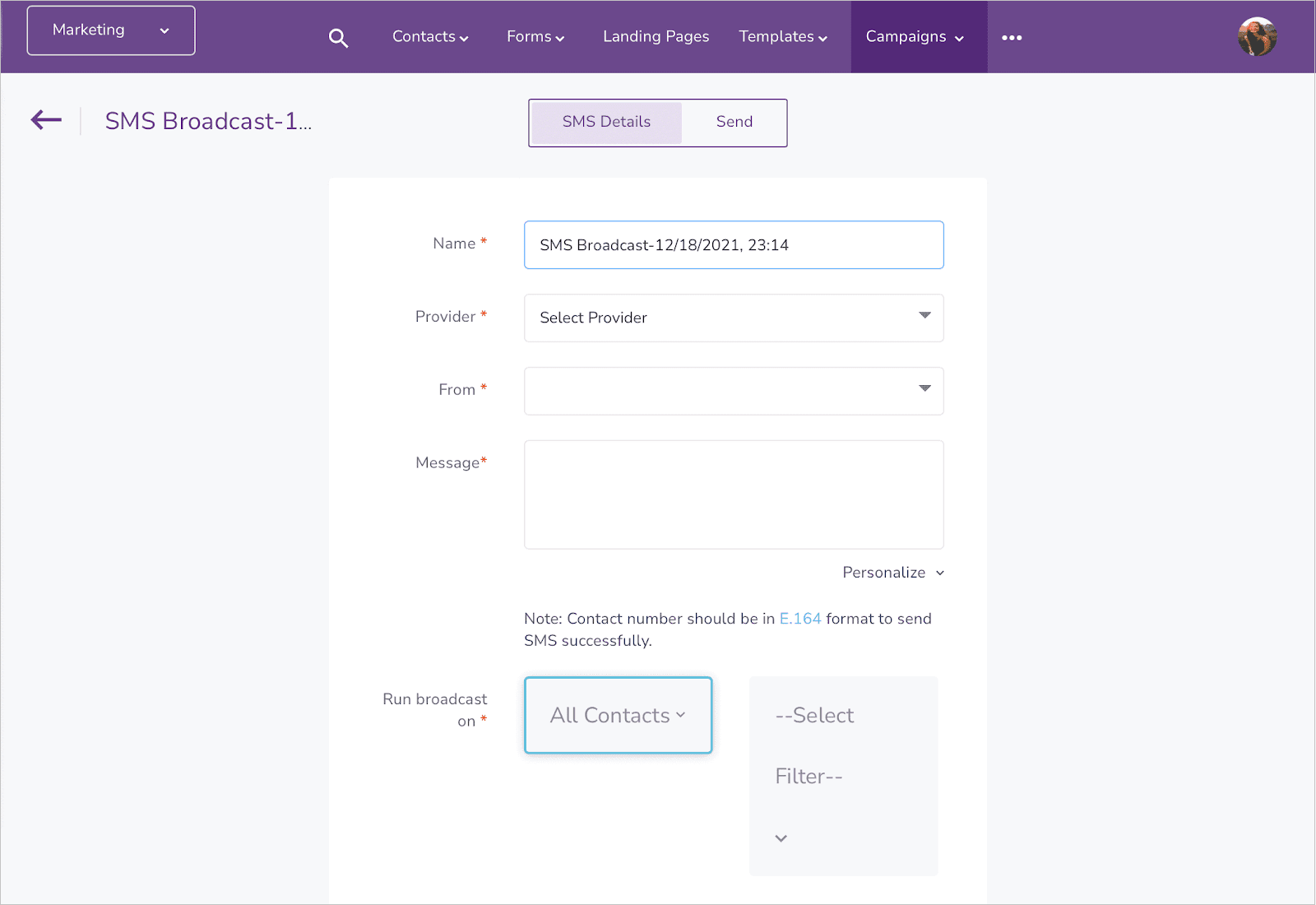
Standout Features
- All-in-one marketing. Combines CRM, email, and automated texting services in one simple interface;
- Behavior-triggered workflows. Create SMS automation workflows from form fills, purchases, or email engagement;
- Two-way messaging. Easily manage replies with built-in CRM notes and support integration;
- Real-time analytics. Monitor click-through rates for SMS and delivery metrics on the go.
Industry Fit
EngageBay is great for businesses that need deeply personalized SMS campaigns without complexity. Here are some use cases:
- SMS marketing for healthcare. Send automated welcome messages, follow-up after inquiries, and nurture leads through the sales funnel with targeted SMS messages.
- SMS marketing for event planners. Promote upcoming events, send reminders, and share important updates with attendees using EngageBay’s SMS campaign tools.
- SMS marketing for real estate. Provide quick and efficient customer support by answering questions, resolving issues, and gathering feedback through two-way texting.
Competitive Edge
EngageBay combines SMS marketing with CRM to simplify marketing and sales for small and mid-sized businesses. Its user-friendly design, affordable flat pricing, and scalable features make it a practical choice for managing campaigns and multi-channel outreach efficiently.
- Combines CRM, email, and SMS under one roof—no need for multiple tools;
- Trigger SMS from user actions like form fills, purchases, or email clicks;
- Simple pricing model with a free tier makes it affordable for growing teams;
- Aligns outreach across departments with shared data and automation flows;
- Has iOS & Android apps; international SMS via third-party tools with variable rates.
It has prebuilt landing pages and templates to be used for my required feature “BroadCast” of Email, SMS, Sequences and Automation. These help a lot to achieve targets.
– Muhammad from G2
7. SlickText — Text Marketing Platform with Great Analytics Features
SlickText is a user-friendly text marketing platform that prioritizes ease of use and powerful analytics. This SMS marketing platform blends a clean design, smart workflows, and powerful data—all on a single platform, without technical overwhelm.
Pricing: Starts at $29/month for up to 500 SMS credits | 14-day free trial available
When we tried SlickText for running text message campaigns, what stood out was the analytics dashboard. It didn’t just track delivery—it helped us understand click-through rates for SMS, subscriber trends, and which campaigns were actually driving revenue.
The platform’s campaign builder makes it easy to automate messages, schedule them for the right moment, and personalize flows based on customer behavior.
So, whether you’re growing a list, re-engaging lapsed users, or testing offers, SlickText gives you the data to fine-tune everything.
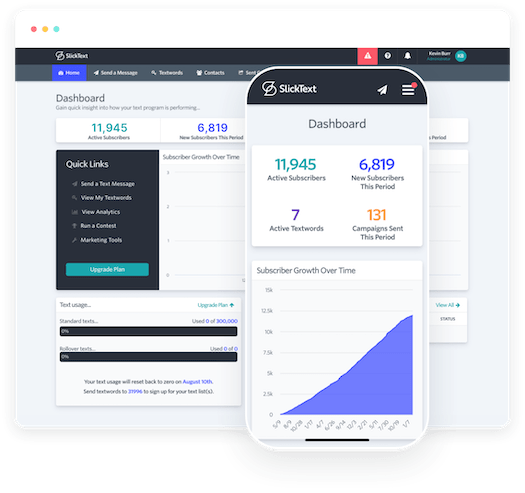
Standout Features
- Simple setup process. Get your SMS automation workflows running within minutes, no tech skills needed;
- Performance insights. Track delivery, clicks, opt-outs, and text message conversion rates with ease.
- Keyword control. Manage and optimize keywords + shortcodes to send promotional text messages that are relevant;
- Integrations. Connect easily with CRMs, email platforms, and landing page tools.
Industry Fit
SlickText is a useful tool for businesses that want to run engagement-driven campaigns and utilize deep data. Here are some businesses that can benefit:
- Small businesses. Run interactive SMS contests and giveaways to boost engagement and grow your subscriber list;
- Online retailers. Reward your loyal customers with exclusive offers, discounts, and updates delivered directly to their phones;
- Service providers. Gather valuable customer feedback and testimonials through SMS surveys and polls.
Competitive Edge
SlickText stands out by delivering a great mix of ease and insight. Its focus on subscriber growth tools and ROI tracking makes it perfect for brands that want to experiment, optimize, and scale with confidence. Built-in feedback loop is what makes SlickText especially powerful for mobile marketing strategy.
- Get real-time insights on clicks, opt-outs, and engagement trends;
- Create campaigns around branded keywords and shortcodes for faster opt-ins;
- Set up and schedule texts effortlessly—no tech skills required;
- Built-in features to grow and manage your SMS subscriber base effectively;
- Has iOS & Android apps; limited international SMS, mainly US & Canada focused.
I shopped around for a text marketing platform. I have not found another service that compares. The way they offer opt-in links, abilities to incentivize subscribers, and so much more.
– Dennis from G2
8. MessageDesk — Best SMS Service for Business Texting
MessageDesk caters specifically to businesses looking for a reliable and professional SMS service to enhance their communication with customers and employees. It offers a secure and compliant platform for sending and receiving business text messages.
This is particularly helpful for industries with strict regulations, such as healthcare, where a dedicated SMS messaging app is crucial.
Pricing: On-demand pricing model available on request.
When we used MessageDesk, we couldn’t ignore a massive advantage—the shared team inbox. You can assign messages to team members, use tags, and manage replies without any confusion or overlap. Plus, features like toll-free messaging, contact groups, and auto-replies help respond faster and more effectively.
It’s also a SMS compliance-focused platform we came across. With secure messaging and CRM-style contact management, MessageDesk is ideal for businesses where trust and communication go hand in hand.
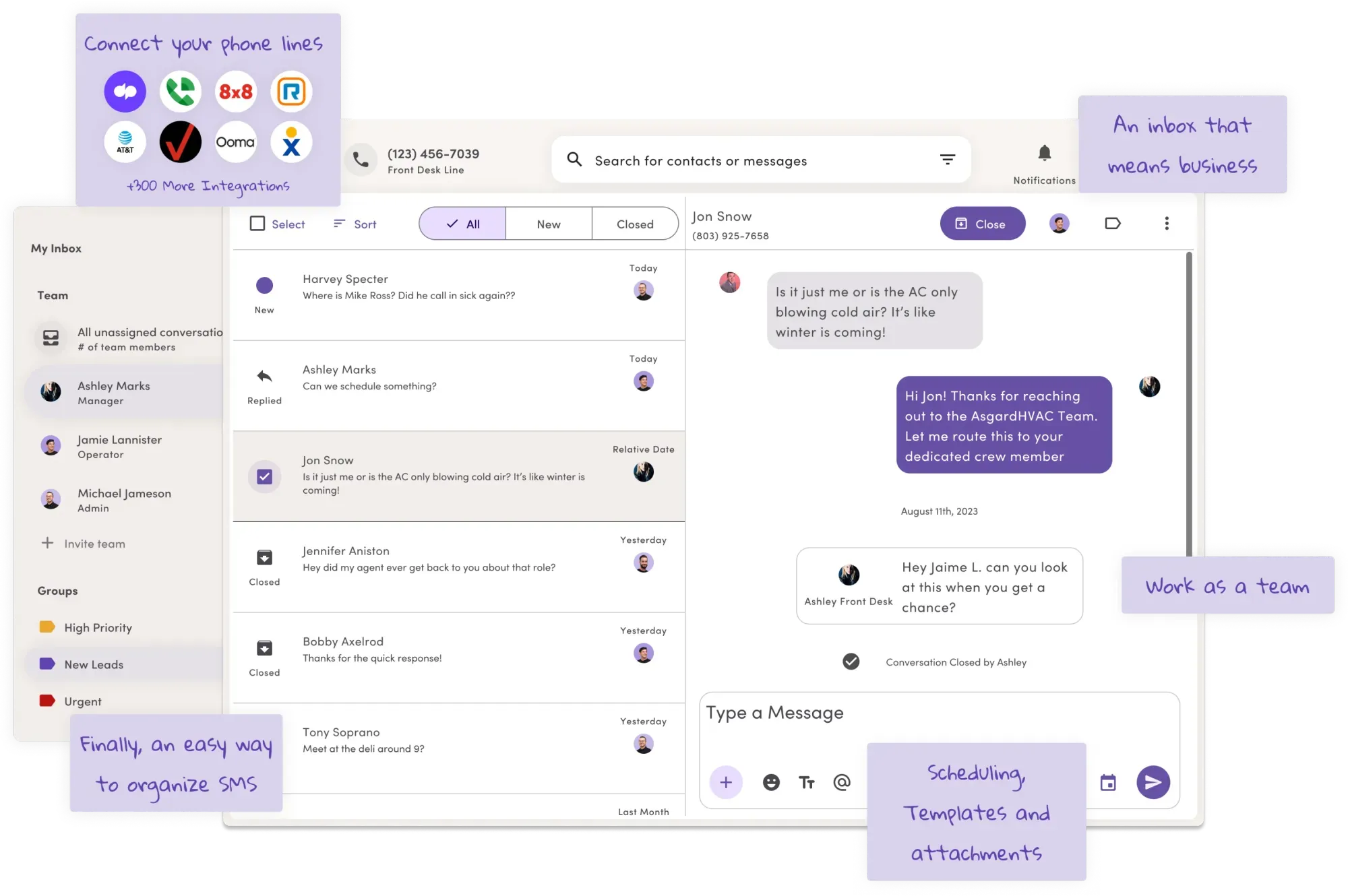
Standout Features
- Team collaboration tools. Assign conversations, use templates, and centralize SMS in a shared inbox;
- Secure message delivery. Prioritizes text message privacy laws and supports two-factor authentication via SMS;
- Flexible sending options. Use VoIP, landline, or toll-free messaging to maintain a consistent sender identity;
- CRM-style contact tools. Organize, tag, and manage contacts like a built-in customer database.
Industry Fit
MessageDesk is good for businesses that rely on organized, secure communication with both customers and internal teams.
- Internal team communication. Improve internal communication and collaboration by using SMS for team updates, announcements, and quick questions;
- Customer service and support. Provide timely and efficient customer support by responding to inquiries, resolving issues, and sending personalized messages;
- Healthcare. Reduce no-shows and improve efficiency by sending automated appointment reminders, confirmations, and updates.
Competitive Edge
MessageDesk sets itself apart by turning business SMS into a truly collaborative and secure business channel. While many platforms treat texting as a solo tool, MessageDesk is team-first—built for assigning tasks, managing multiple users, and staying compliant at every step.
- Assign conversations, track replies, and avoid message overlap with team collaboration tools;
- Prioritizes SMS privacy laws, with tools for safe customer and internal communication;
- CRM-style contact tags to group and manage contact lists like a lightweight CRM;
- Flexible sending options with VoIP, landline, or toll-free numbers to maintain sender consistency;
- Has iOS & Android apps; supports international SMS with destination-based pricing.
I like how you can organize contacts into groups instead of clicking every contact individually. It helps us reach the target audience. Using our office number for the app helps clients verify the legitimacy of the message as opposed to a spam text.
– Kristi from G2
9. Textedly — Text Message Marketing for Two-Way Messaging
Textedly is designed for businesses that want SMS to feel more like a conversation than a broadcast. It’s a useful SMS marketing platform for customer-facing teams looking for a solution for quick replies or lead follow-ups.
It’s a particularly strong option for service-based businesses that rely on appointment reminders and quick communication.
Pricing: Starts at $26/month for 500 SMS credits | Free trial available for up to 50 SMS.
We found its two-way texting features especially effective for appointment confirmations and live support. The shared team inbox and conversation tracking tools made it easy to manage replies without losing context.
Setting up SMS automation workflows was also simple. You can trigger messages via keywords, send scheduled promotions, and personalize texts using contact data. It’s a lightweight platform that delivers strong SMS delivery rates and smooth performance.
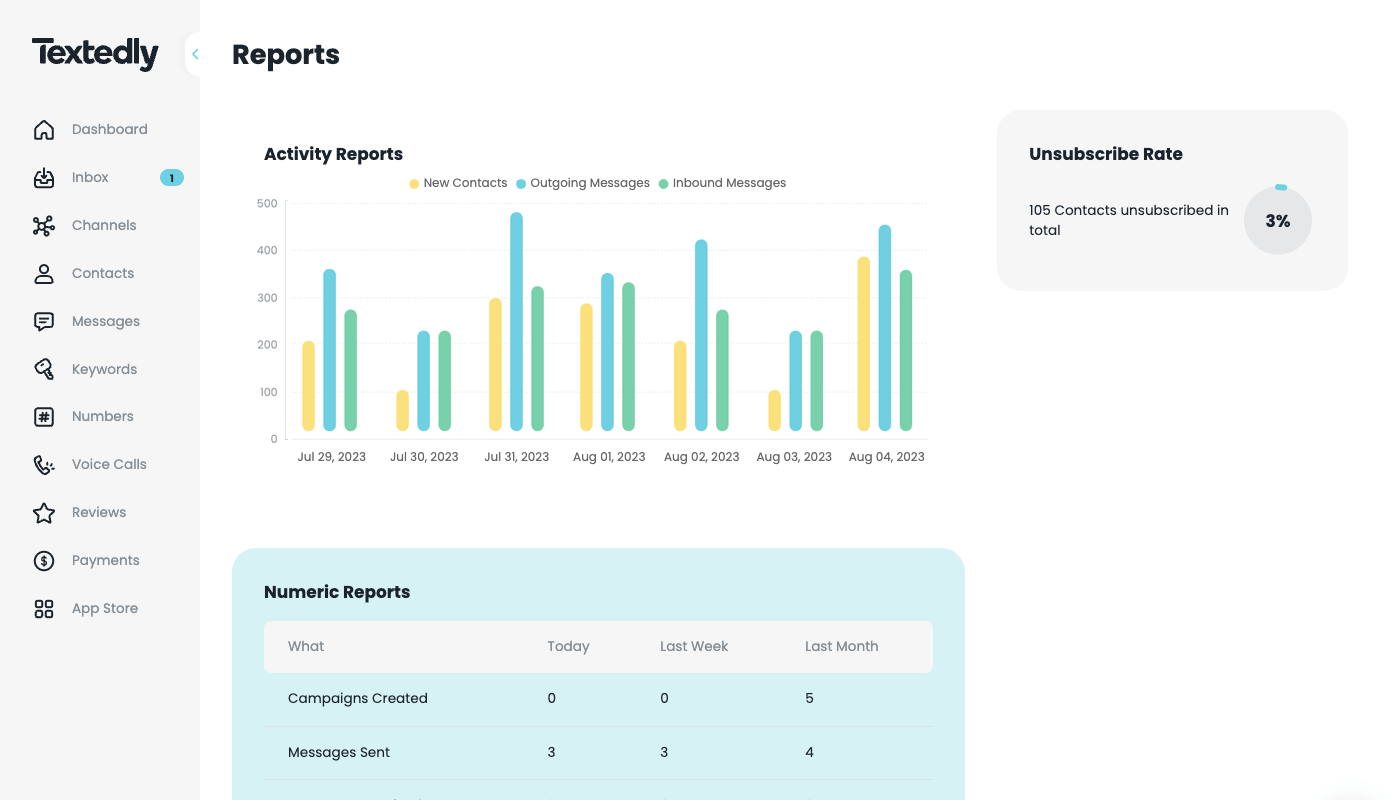
Standout Features
- Live SMS replies. Manage two-way messaging at scale with team collaboration and customer history;
- Keyword automation. Use custom triggers to automate FAQs and support with minimal effort;
- Contact management. Organize and segment contacts for more effective text message campaigns;
- Real-time reporting. Track delivery, response time, and click-through rates for SMS.
Industry Fit
Textedly is best for businesses where quick back-and-forth and personalized conversation matters. Here are the most promising use cases:
- Customer service and support. Provide quick and efficient customer support by answering questions, resolving issues, and gathering feedback;
- Sales teams. Qualify leads and gather information from potential customers through interactive text conversations;
- Healthcare companies. Allow customers to book appointments or reschedule existing ones through two-way text messaging.
Competitive Edge
Textedly’s edge lies in its clarity and simplicity. It’s not bloated with unnecessary features and is focused primarily on fast and reliable two-way communication. If your brand depends on quick customer touchpoints, Textedly helps you collect phone numbers, stay responsive, and build trust—all through one clean dashboard.
- Two-way conversation tools to manage real-time replies with shared inbox and customer history tracking;
- Keyword-based triggers for setting up auto-replies, FAQs, or promos using keyword automation;
- Fast onboarding with easy to set up flows, even for teams new to SMS marketing;
- Solid SMS deliverability and uptime across regions and different use cases;
- Supports international numbers with country-based SMS pricing.
I’ve been using Textedly for my clients, and it has streamlined our communication tremendously. The platform is user-friendly, reliable, and the support team is always responsive.
– Hector from G2
10. SimpleTexting — Intuitive All-in-One Text Marketing Solution
SimpleTexting lives up to its name, offering a straightforward and user-friendly SMS marketing platform. It provides a comprehensive suite of features designed to make launching and managing SMS campaigns a breeze.
It’s ideal for brands just getting into text message campaigns, but it’s equally capable for high-volume marketers.
Pricing: Starts at $29/month for 500 local SMS credits | Free trial available
We used SimpleTexting and found it surprisingly easy to use. It only took minutes to set everything up. From text-to-win contests to drip SMS automation workflows, everything felt smooth and low-lift.
Its integrations with tools like HubSpot and Zapier made it easy to pull in contact data and sync messages across platforms.
So, whether you’re collecting opt-ins via web forms or launching segmented promotional SMS campaigns, SimpleTexting helps you get the right message out at the right time, without overwhelming your team.
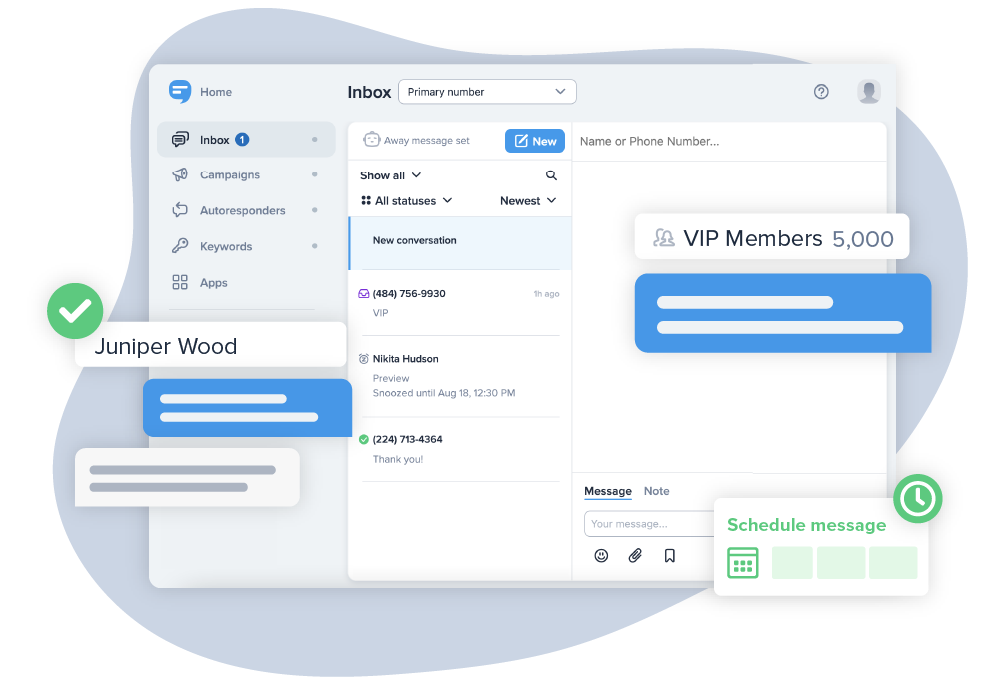
Standout Features
- Real-time analytics: Track click-through rates for SMS, engagement, and unsubscribes in a clean dashboard;
- Drip automation. Schedule messages over time to onboard, nurture, or upsell your audience;
- Opt-in growth tools. Use shortcodes, forms, and keywords to collect phone numbers easily;
- Tool integrations. Seamlessly connect with CRMs and email tools to run cross-channel marketing integration.
Industry Fit
SimpleTexting is great for growing engagement through interactive campaigns and subscriber-focused outreach. Here are some use cases:
- Welcome messages and promotions. Send automated welcome messages to new subscribers and promote special offers, discounts, and new products;
- Event marketing. Promote upcoming events, send reminders, and share important updates with attendees via SMS;
- Customer feedback and surveys. Collect valuable customer feedback and insights through SMS surveys and polls.
Competitive Edge
SimpleTexting is a user-friendly platform that simplifies SMS marketing for small teams. Unlike feature-heavy tools, it offers what you need without the learning curve. From list-building to SMS automation tools, it’s built to help campaigns launch quickly and effectively.
- Drip campaign builder to automate onboarding, follow-ups, and promo sequences with ease;
- Opt-in growth tools like shortcodes, web forms, and keywords to grow your SMS list fast;
- Clean user experience with an intuitive dashboard helps teams launch campaigns in minutes, not hours;
- Wide range of integrations to connect with CRMs and email platforms like HubSpot and Mailchimp;
- Has iOS & Android apps; supports international SMS, pricing varies by country.
Sales and troubleshooting is always quick and responsive. Delivery of messages is excellent, in over a million messages sent thus far, we’ve had a single campaign fail to deliver as expected.
– Madeline from G2
11. Attentive — Best SMS Marketing Platform for Personalized Text
If personalization is your priority, Attentive is one of the most promising SMS marketing platforms. It turns simple SMS marketing campaigns into highly tailored conversations, helping you connect with subscribers in a way that makes the most impact.
Pricing: On-demand pricing model available upon request
The first thing that came to our mind when we started checking out Attentive was to use it for abandoned cart recovery and boost repeat buys.
When we tested it for the use case, the power of its segmentation and AI-driven message personalization became clear. You can send behavior-based texts—like follow-ups on products viewed or personalized birthday offers—and see real engagement lift.
The real-time replies and automation tools make the experience feel like 1:1 support, not a mass blast. It also comes with built-in SMS compliance features, two-way messaging, and detailed analytics.
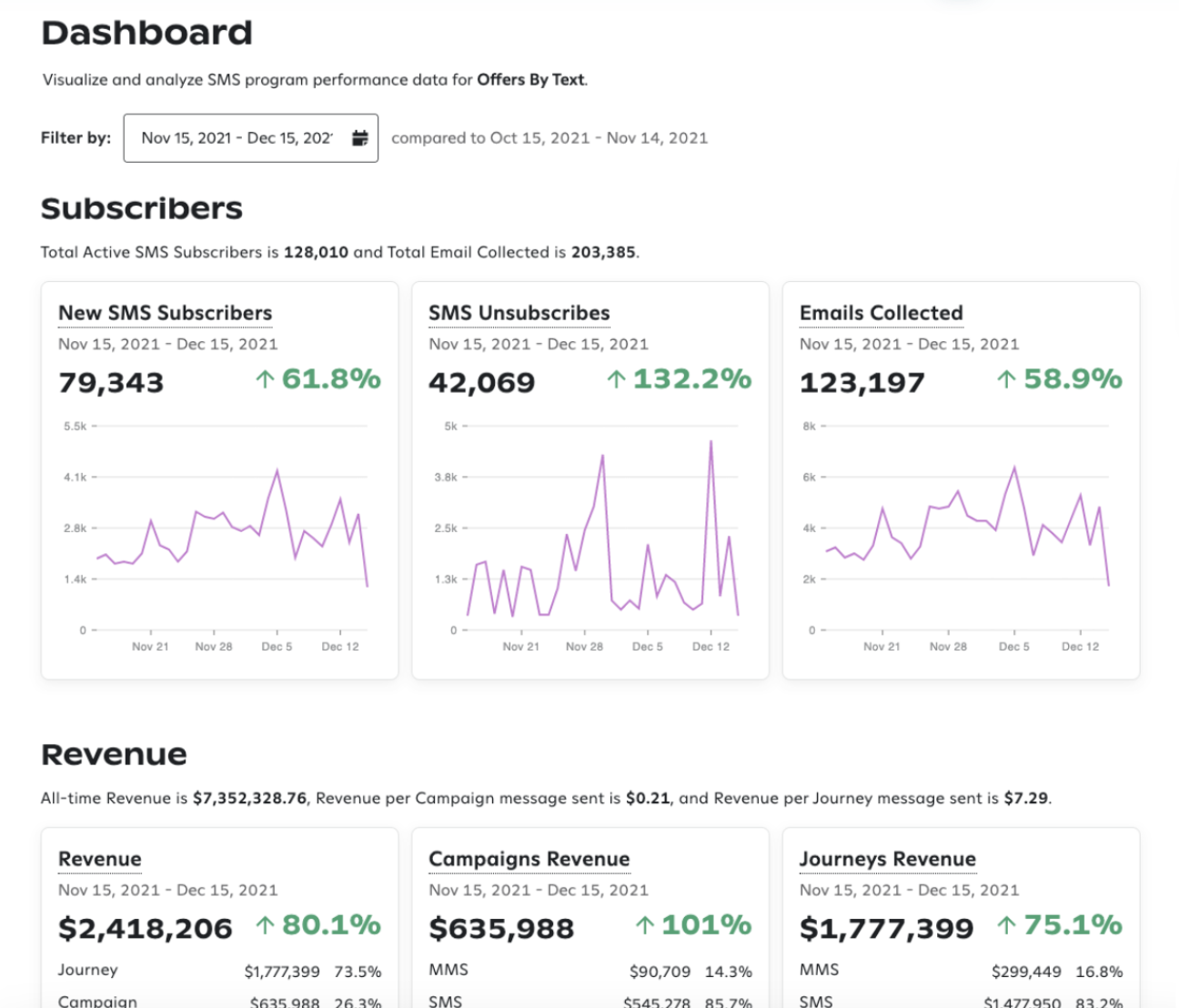
Standout Features
- Behavioral targeting. Trigger messages based on real-time actions, product views, or cart activity;
- AI-powered personalization. Automatically tailor texts based on preferences and past behavior;
- Two-way engagement. Respond to customers in real time through business texting solutions;
- Shopify integration. Sync product data, automate flows, and build text message campaigns that convert.
Industry Fit
Here are some of the business use cases where Attentive can be the perfect fit for boosting customer engagement:
- Ecommerce. Suggest relevant products to customers based on their browsing history, past purchases, and preferences;
- Mid-level businesses. Reward your most loyal customers with exclusive discounts, early access to sales, and personalized birthday messages;
- Service providers. Re-engage inactive customers with targeted offers, personalized incentives, and reminders to return to you.
Competitive Edge
Attentive stands out among SMS automation tools for personalization at scale. It doesn’t just segment—it learns. By boosting text message conversion rates and streamlining workflows, it helps businesses elevate their mobile messaging services with smart automation and deep customer insight.
- AI-driven personalization to automatically tailor messages based on user behavior and preferences;
- Real-time messaging for responding to customer actions instantly with dynamic, behavior-based triggers;
- Deep ecommerce focus with Shopify and DTC-friendly tools for abandoned cart, restock alerts, and more;
- Strong compliance features with built-in opt-in, opt-out, and privacy controls to meet regulations globally;
- Supports SMS in 20+ countries with variable pricing.
The platform not only helped us significantly grow our subscriber base but also boosted customer engagement and bolstered ROI with our top customers. Its AI-powered tools make creating new message campaigns effortless, reducing workload while delivering impressive results.
– Deborah from G2
12. Postscript — SMS Marketing Service Built for Shopify Stores
If you run a Shopify store and want to get serious about text message campaigns, Postscript should be on your radar. It’s one of the few SMS marketing platforms purpose-built for ecommerce, with features that feel tailor-made for Shopify brands.
Pricing: Pay as you go plan with minimum $30/month | 30-day free trial available.
When we tested Postscript, we found its integration with Shopify stores seamless. Everything syncs automatically—from order history and product views to loyalty status. You can create SMS automation workflows that feel highly personalized without writing a single line of code.
We especially liked its event-triggered campaigns—for post-purchase messages, flash sales, and product review requests. Add in MMS support, and you’ve got a full-featured mobile marketing strategy that’s built to convert, not just communicate.
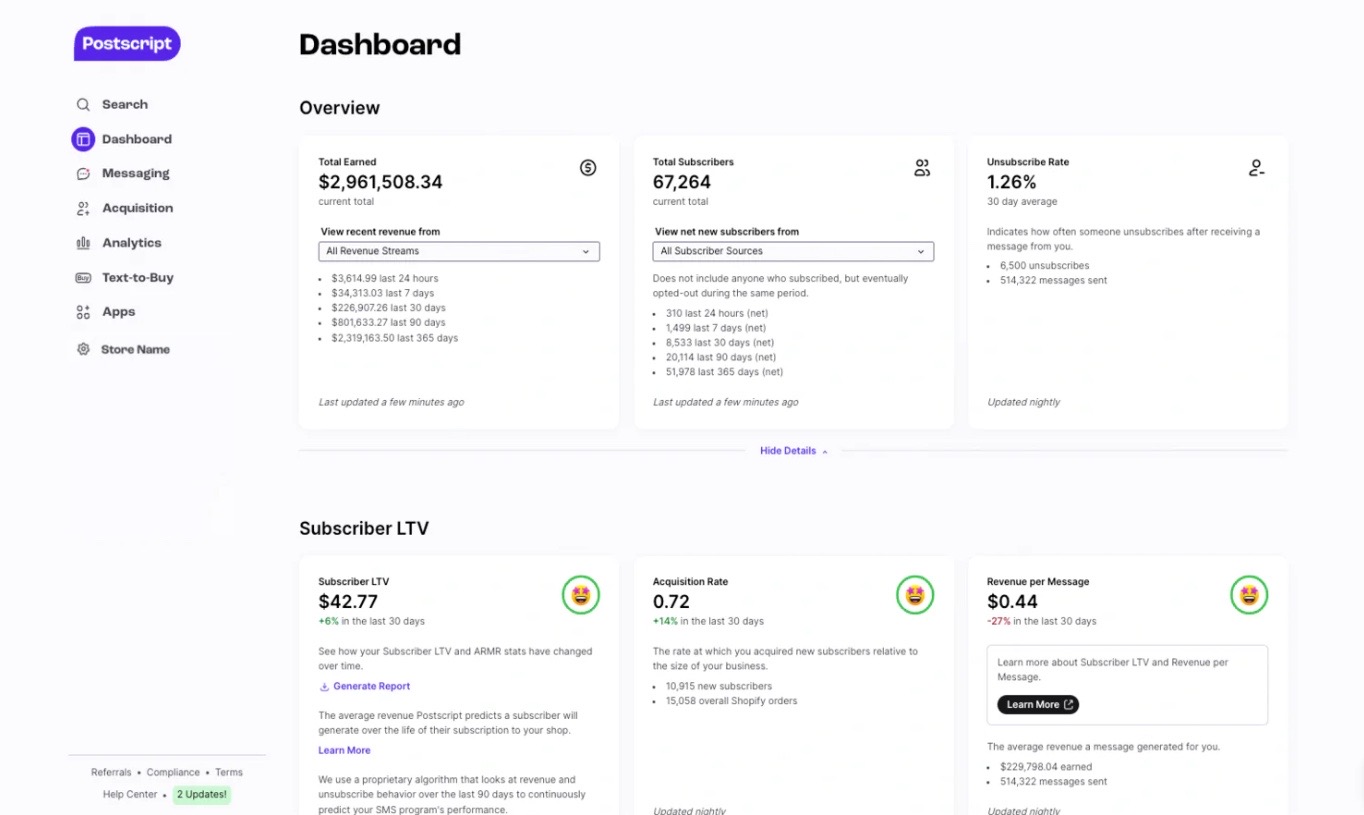
Standout Features
- Native Shopify sync. Pull in customer, order, and product data in real-time for better targeting;
- Ecommerce-first automations. Recover carts, follow up post-purchase, or launch loyalty promos;
- MMS support. Use GIFs or product visuals to boost engagement and text message conversion rates;
- TCPA compliance tools. Built-in SMS consent management and delivery tools for safe scaling.
Industry Fit
Postscript is suitable for ecommerce brands that run frequent sales and want better control over revenue-driving messages. Here are some interesting use cases for different industries:
- Ecommerce. Recover lost sales by automatically sending personalized SMS messages to shoppers who left items in their carts;
- Creators. Drive repeat purchases by sending targeted product recommendations, exclusive offers, and loyalty program updates;
- Online retailers. Keep customers informed about their orders with automated shipping notifications, delivery confirmations, and tracking information.
Competitive Edge
Postscript’s competitive edge is focus—it’s built for Shopify and ecommerce. Every automation, every segment, every integration is designed to help you move products and boost text message conversion rates. Its deep understanding of ecommerce behavior makes it easier to build cross-channel marketing integration that actually performs.
- Pulls in real-time product, order, and customer data from Shopify with zero hassles;
- Ecommerce-specific automations to recover carts, upsell post-purchase, and trigger flows based on store events;
- MMS and rich media support to send GIFs, product photos, and links;
- Built-in TCPA compliance and opt-in/opt-out management for peace of mind;
Partnering with Postscript has been a no-brainer for us. SMS is the perfect channel to both reliably reach our best customers and build our brand.
– Matt from G2
13. Zonka Feedback — Real-Time Customer Feedback with SMS Surveys
Zonka Feedback is a customer experience platform that allows businesses to collect real-time feedback through various channels, including SMS. This is especially useful for industries like restaurants and retail, where immediate feedback is crucial.
Pricing: Starts at $49/month for 250 responses | Free plan for up to 50 responses.
We used Zonka Feedback to set up SMS surveys after purchase or a visit. What stood out was the event-based survey triggers—you can instantly follow up after a support interaction or completed transaction. The platform’s SMS automation workflows help you time outreach perfectly, while the mobile-first UI ensures customers actually respond.
Its sentiment analysis and real-time analytics give you more than just ratings—you get insight into patterns, pain points, and loyalty gaps. If you’re serious about using feedback to fuel growth, Zonka makes it easy to act fast.
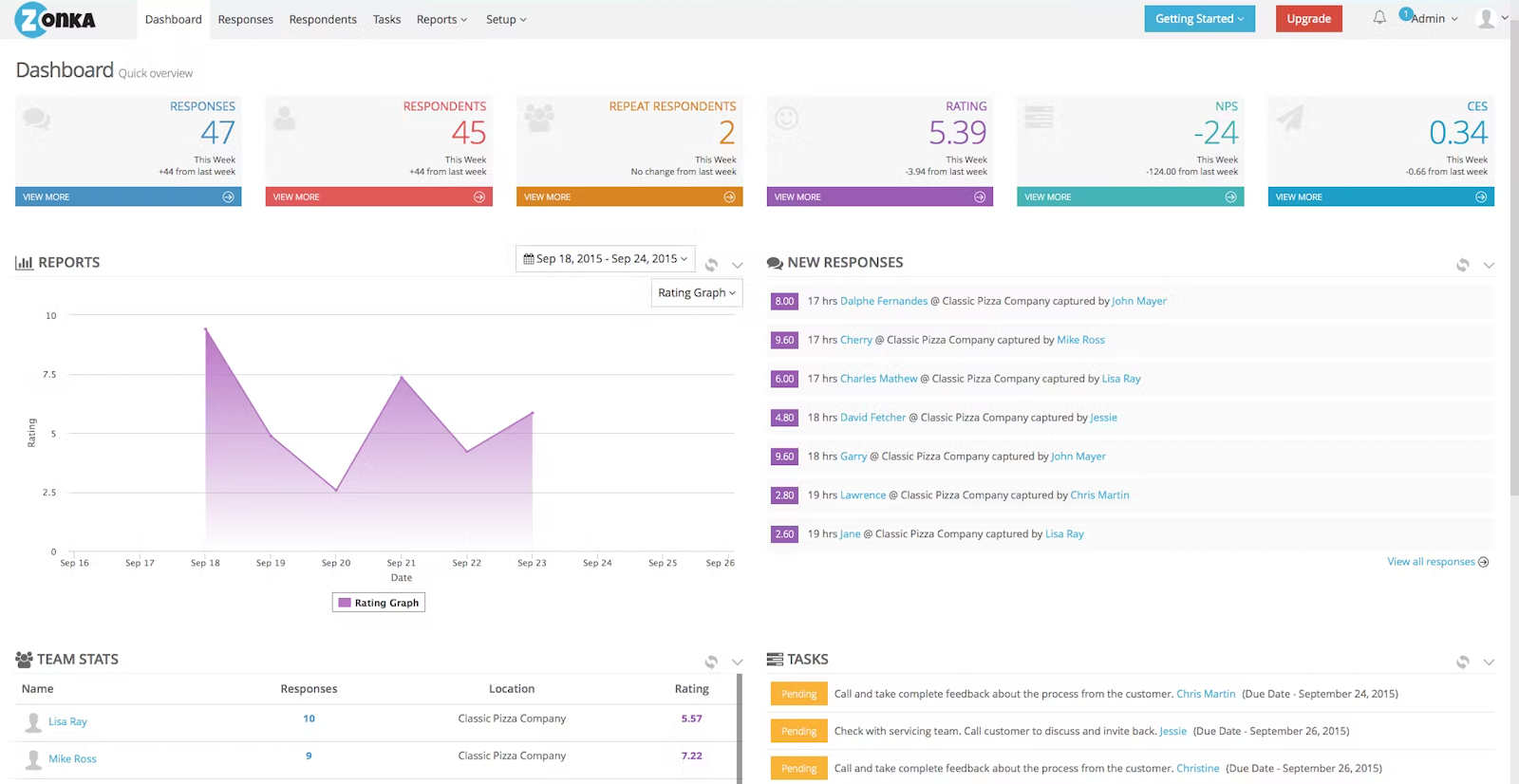
Standout Features
- Mobile-optimized surveys. Clean UX across iOS and Android apps to maximize response rates;
- Event-triggered outreach. Send surveys after purchases, visits, or interactions using automated texting services;
- Sentiment tracking. Analyze tone and satisfaction using built-in text message conversion rates data;
- Multi-channel feedback. Collect responses via SMS, email, web links, and in-app tools.
Industry Fit
Zonka Feedback is useful for feedback-driven businesses that want to optimize service and understand customer experience. Here are some use cases:
- Ecommerce. Gather feedback on the customer experience immediately after purchase, identifying areas for improvement;
- Restaurants and service providers. Measure customer satisfaction with your support team by sending surveys after interactions;
- Event marketers. Collect feedback from attendees after an event to gauge satisfaction and gather insights for future events.
Competitive Edge
Zonka Feedback is focused at real-time feedback collection. Unlike generic survey tools, Zonka offers built-in SMS compliance, powerful automation, and integrations with CRMs and helpdesks like Zendesk. It’s designed for teams who want to collect and act on data via SMS campaigns.
- Mobile-optimized surveys ensure high response rates on both iOS and Android devices;
- Event-triggered SMS to automatically send feedback requests post-purchase, support, or interaction;
- Sentiment analytics to go beyond ratings for tracking customer emotion and satisfaction over time;
- Multi-channel collection to gather feedback via SMS, email, or in-app, wherever customers engage;
- Has iOS & Android apps; supports international SMS to 100+ countries, rates vary based on destination.
What I like the most about Zonka is that you can create as many surveys as you want, and distribute them offline, via email, SMS and integration with Zendesk.
– Kurt from G2
Features to Look for in SMS Marketing Solution
Now, let’s look at some must-have features all blast texting services should have to help you grow your audience and boost revenue:
| Top features look to for in text marketing software: | |
| Bulk messaging. This helps you send personalized bulk SMS messages to many customers simultaneously. | Two-way conversation. Two-way messaging allows you to have one-on-one conversations with customers to increase engagement and conversions. |
| API. It lets you connect the SMS marketing software with your website or any other system and synchronize all customer data automatically. | Opt-out management. Allows users to opt out of receiving your text messages so you can maintain compliance. |
| Contact list building. Tools like popups and signup forms enable you to gather customers’ information and grow your audience. | Omnichannel capabilities. Omnichannel features help you combine various platforms like email and SMS to offer customers more personalized experiences. That way, you can boost engagement and conversions. |
| Shortcodes. Shortcodes simplify the opt-in process and enable two-way SMS conversations. | Segmentation. This feature helps you group customers into specific segments to send them relevant, personalized text message campaigns. |
| Automation. With SMS automation, you can send abandoned carts, welcome, follow-up, and many other messages based on specific triggers. | Integrations. Integrations help you combine your SMS platform with other business tools and manage them on one dashboard. |
| Analytics and link tracking. This lets you get notifications whenever customers click the links in your SMS messages. | MMS. This lets you embed media into your text messages, including images, videos, and GIFs. |
Benefits of Using Text Message Marketing
Apart from being a top customer engagement channel, SMS is much more effective than other platforms, with an open rate of 98% and a reply rate of 45%.
With that in mind, let’s look at some key benefits of SMS marketing:
- Reach customers on the go. SMS marketing helps you connect with customers wherever they are and build lasting relationships.
- Fast and efficient audience reach. With SMS campaigns, you can contact customers directly on their phones and send them highly personalized offers.
- Targeted personalization and segmentation. You can segment customers based on their preferences and needs and then send them relevant SMS messages to boost engagement and sales.
- High open and response rates. As mentioned, SMS offers a massive open rate of 98% and a reply rate of 45%. With the right marketing strategies, you can be sure that almost all your customers will open and respond to your messages.
- Cost-effective. With marketing automation tools like Sender, you won’t have to break the bank to connect with customers using SMS. The platform offers affordable yet powerful SMS marketing services.
- Tracking and measurement capabilities. SMS analytics and reporting help you analyze how well your SMS campaigns perform so you can find ways to improve them.
- Integration with existing tech stack. Integration helps you connect your SMS service with other business tools to manage all your data in one place.
- Scheduling and automation. With scheduling, you can send automated messages to customers at the right time to boost engagement.
- Easy setup and management. Easy-to-use platforms like Sender enable you to build, run, monitor, and optimize high-converting SMS campaigns effortlessly.
SMS Marketing FAQs
What are the key TCPA requirements for SMS marketing?
It is mandatory to get express written consent under The Telephone Consumer Protection Act (TCPA) before sending marketing texts. Your subscribers must clearly agree to receive promotional SMS from you, usually by ticking a box or entering their number in an opt-in form.
You also need to include clear opt-out instructions in every message (like “Reply STOP to unsubscribe”) and avoid sending messages to numbers on the National Do Not Call Registry.
How does GDPR affect my SMS marketing campaigns in Europe?
You must get clear, informed consent before sending SMS messages to people in the EU for GDPR compliance. This means users need to know what kind of messages they’re signing up for and how their data will be used. You also need to keep records of their consent and give them an easy way to opt out or request deletion. If you’re using automated texting services, make sure your platform supports proper data handling and privacy controls to stay compliant.
Are there specific time restrictions for sending marketing text messages?
Yes. In most countries, including the U.S., you can only send marketing text messages during business hours, typically between 8 AM and 9 PM (local time of the recipient). Sending messages outside this window can violate TCPA or similar laws and lead to poor customer experiences. Some SMS automation tools let you set time restrictions or schedule messages for later, so you’re always texting at the right time. Always check local laws if you’re running international text message campaigns.
How do I ensure compliance with SMS marketing laws?
Start by getting proper consent before sending any marketing texts. Use double opt-in if possible, and always make it easy for users to opt out. Stick to allowed sending hours and include your business name in messages for transparency. Choose an SMS marketing platform that supports compliance features like opt-out management, toll-free messaging, and secure SMS API integration. Also, keep updated on regional laws like TCPA, GDPR, or international SMS regulations to avoid fines and protect your brand reputation.
